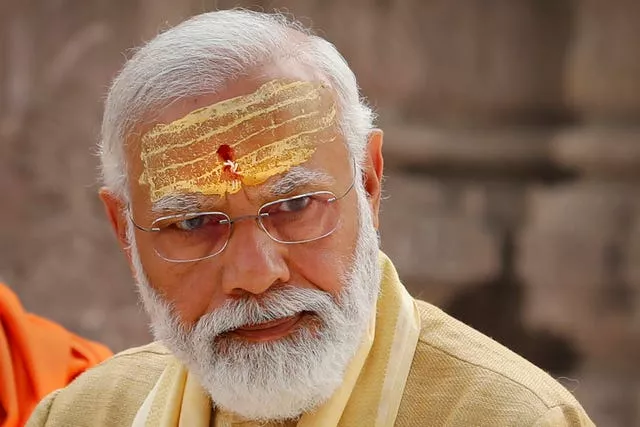Prime Minister Narendra Modi’s coalition is leading in a majority of seats in India’s general election, according to early figures.
However, Mr Modi’s coalition faces a stronger challenge from the opposition than expected after it pushed back against the leader’s mixed economic record and polarising politics.
The counting of more than 640 million votes cast over six weeks in the world’s largest democratic exercise is likely to take all day. Mr Modi is still widely expected to be elected to a third five-year term – even as the race tightens and the early count showed his party might not secure a majority on its own.
If Mr Modi wins, it would cement the 73-year-old as one of the country’s most popular and important leaders. It would only be the second time an Indian leader has retained power for a third term after Jawaharlal Nehru, the country’s first prime minister.
In his 10 years in power, Mr Modi has transformed India’s political landscape, bringing Hindu nationalism, once a fringe ideology in India, into the mainstream while leaving the country deeply divided.
His supporters see him as a self-made, strong leader who has improved India’s standing in the world. His critics and opponents say his Hindu-first politics have bred intolerance and while the economy, the world’s fifth-largest and one of the fastest-growing, has become more unequal.
Some seven hours into counting, early leads reported by India’s Election Commission showed Mr Modi’s Bharatiya Janata Party (BJP) was ahead in 236 constituencies and had won two, including one uncontested, of 543 parliamentary seats. The main opposition Congress party led in 99 constituencies.
A total of 272 seats are needed for a majority. In 2019, the BJP won 303 seats.
Mr Modi’s party is part of the National Democratic Alliance (NDA), whose parties led in 287 constituencies, according to the early count, including the two won by BJP. The Congress party is part of the India alliance, which led in 230 constituencies.
The Election Commission does not release data on the percentage of votes tallied, and early figures are expected to change.
“(The) Congress party and other opposition parties have showed tremendous resilience. To have a stronger opposition augers very well for India’s democracy that has taken a hit during Modi’s 10-year rule,” said political analyst Rasheed Kidwai.
Exit polling from the weekend had projected the NDA to win more than 350 seats. Indian markets, which had hit an all-time high on Monday, closed sharply down on Tuesday, with benchmark stock indices – the Nifty 50 and the BSE Sensex – both down by more than 5%.
Extreme heat struck India as voters went to the polls, with temperatures higher than 45C in some parts of the country. Temperatures were somewhat lower on Tuesday for the counting, but election officials and political parties still took precautions, hauling in large quantities of water and installing outdoor air coolers for people waiting for results outside the buildings where votes were being tallied and party headquarters.
BJP workers outside the party’s office in New Delhi performed a Hindu ritual shortly after the counting began. Meanwhile, supporters at the Congress party headquarters appeared upbeat.

Over 10 years in power, Mr Modi’s popularity has outstripped that of his party’s, and has turned a parliamentary election into one that increasingly resembles a presidential-style campaign. The result is that the BJP relies more and more on Mr Modi’s enduring brand to stay in power, with local politicians receding into the background even in state elections.
“Modi was not just the prime campaigner, but the sole campaigner of this election,” said Yamini Aiyar, a public policy scholar.
The country’s democracy, Mr Modi’s critics say, is faltering under his government, which has increasingly wielded strong-arm tactics to subdue political opponents, squeeze independent media and quash dissent. The government has rejected such accusations and says democracy is flourishing.
And economic discontent has simmered under Mr Modi. While stock markets reach record-highs and millionaires multiply, youth unemployment has soared, with only a small portion of Indians benefiting from the boom.
As polls opened in mid-April, a confident BJP initially focused its campaign on “Modi’s guarantees”, highlighting the economic and welfare achievements that his party says have reduced poverty. With him at the helm, “India will become a developed nation by 2047,” Mr Modi repeated in rally after rally.
But the campaign turned increasingly shrill, as Mr Modi ramped up polarising rhetoric that targeted Muslims, who make up 14% of the population, a tactic seen to energise his core Hindu majority voters.
The opposition India alliance has attacked Mr Modi over his Hindu nationalist politics, and campaigned on issues of joblessness, inflation and inequality.
But the broad alliance of over a dozen political parties has been beset by ideological differences and defections, raising questions over their effectiveness. Meanwhile, the alliance has also claimed they have been unfairly targeted, pointing to a spree of raids, arrests and corruption investigations against their leaders by federal agencies they say are politically motivated. The government has denied this.
Signup bonus from




